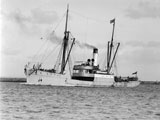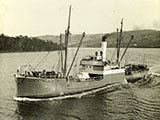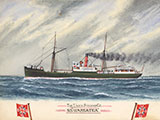Wareatea
![]() Wreck Dive |
Wreck Dive | ![]() Boat access
Boat access
![]()
![]()
![]()
![]()
Passenger and Cargo Steamer | Max Depth: 48 m (157 ft) — Graveyard
The Wareatea was built in 1883 in Paisly, Scotland. It was first used as a collier in New Zealand, and later in the Bass Strait trade carrying passengers and freight. She ran between Melbourne and the North coast of Tasmania between Federation in 1901 and the end of WWII in 1945.
After decommissioning, the stripped down hulk was scuttled in the Victorian Ships' Graveyard on 16 March 1945.
Diving the Wareatea Shipwreck
Wreck of the Wareatea, by Jane Headley.
Bass Strait Warning: Always keep an eye on sea conditions throughout any shore or boat dive in Bass Strait on Victoria's coastline. Please read the warnings on the web page diving-in-bass-strait before diving or snorkelling this site.
Wareatea Shipwreck History — Built in 1883
The Wareatea was an iron steamer of 511 tons gross, built in 1883, by H. McIntyre & Co., in Paisley, Scotland. The overall length of the vessel was approximately 170.2 ft (52 m), with a beam of 26.1 ft (7.96 m) and a draught of 11.4 ft (3.47 m). She was pwered by a 70 nominal horsepower steam engine.
On Friday 21 April 1905, the Wareatea passed Williamstown at dusk. At 7:30 p.m. a loud escape of steam was heard from the engine compartment. Mr Harry Cameron, the chief engineer immediately made a personal investigation. He found the water running from the boilers through the furnaces. By his direction the fires were at once drawn, and he was then enabled to more closely examine into the cause of the accident. The result showed that the back plate of the combustion chamber having been blown off or sprung from the studs by which it was secured. Captain Kean anchored, and signalled for the assistance of a tug. Rockets were sent up, but he could not attract attention. At daybreak he had a boat launched, and the chief officer Mr Hawkes with three men, rowed for 3.5 hours to Williamstown and raised the alarm. The steam tug Racer was dispatched to render assistance. The passengers were transhipped to the Loongane.
The Wareatea passed through The Heads at 9 p.m. on Tuesday 23 April 1907, but returned at 5 a.m. the next day with a fire in the forehold among the straw cargo. She was berthed at Middle Island and water puped into the holds.
On 30 November 1908, the steamers Glaucus and Wareatea collided in the vicinity of Point Nepean. The Glaucus (884 tons) was bound for Kaipara, New Zealand in ballast. The Wareatea was bound for Launceston, with stock and general cargo. Both vessels continued on their respective voyages.
In August 1910, the steamer Wareatea was towed by the Toroa, from Hobart to Melbourne for repairs. The Wareatea had grounded at Saltpan Point, south of Georgetown in July, and undergone temporary repairs in Launceston. Wareatea's Captain Thomas H. Holyman was fined £1 with costs for having on 18 August 1910, without perminion of the harbourmaster, caused the vesselto enter the River Yarra in a leaky condition, as might endanger the safety of the port, contrary to regulations.
On Monday 1 July 1912, a fire broke out onboard the steamer Wareatea (500 tons), moored at the South Wharf, melbourne. The outbreak was caused by a kerosene heater. The fire brigade, who were summoned by the police, turned out with a large number of men and a quantity of equipment, and the fire was subdued in 37 minutes. The damage was chiefly confined to tho dining saloon, which suffered severely.
On 5 May 1916, the Wareatea reached South Wharf, Melbourne, without her propeller. She had been on a voyage from Launceston.
In May 1916, the Wareatea with engines broken down was towed by the steamer Casino through The Heads, where the tug Myora took over to tow the Wareatea to port. The Wareatea was on a voyage fro Launceston to Melbourne with a cargo of general merchandise when it came into difficulty.
At 1 a.m. on Saturday 5 May 1917, the Wareatea made the port of Burnie. She was proceeding from Launceston to Adelaide via Stanley and Duck River, when about 15 miles off Burnie one of the plates of her boilers blew out. Temporary repairs were made which enabled her to make Burnie at considerably reduced speed. Fitters made the trip from Launceston to Burnie by car and repairs were completed by Sunday afternoon. The Wareatea resumed her voyage at 8 p.m.
The steamer Wareatea ran aground near Beauty Point on the night of Thursday 18 September 1919 whilst en route to Melbourne. She fioated off undamaged, with the morning tide, and continued the voyage to Burnie.
The steamer Wareatea ran aground in the Tamar River at 9 a.m. on Friday 13 April 1923 in a fog just off Rosevears church, on a voyage from Launceston to Agelaide via river ports. The river steamer Remeere passed soon afterwards, but was unable to pull the Wareatea into the stream. The tug Wybia arrived and about 10 p.m. towed the vessel clear and the Wareatea proceeded on her voyage.
The Wareatea was holed by hitting a sunken object in the Tamar River on Friday 12 April 1929. The hole was about three feet by two feet under the hull, about 15 feet from the starboard bow. The Wareatea was temporarily repaired in Launceston during Friday night and Saturday morning, and the vessel left Launceston for Melbourne without cargo, to enter dry dock to have new plates fitted.
On 19 May 1921, the body of Stanley Hambling, 18, was found hanging by the neck on board the steamer Wareatea as the vessel was running between Burnie and Ulverstone. Captain Thomas G. Bennett stated that before leaving Burnie the deceased went ashore and returned intoxicated. He had joined the shop on 19 March 1929.
In July 1923, it was reported the small interstate steamer Wareatea was being towed by the steamer Port Adelaide. The Wareatea was on a voyage from Tasminian ports to Port Adelaide with a full cargo of timber under the command of Captain T. Bennett.
On Wednesday 3 December 1924, a fire broke out in the after-hold of the Wareatea while she was loading case ol at Spotswood (Melbourne) for Hobart. Two thousand cases of benzine were likely to explode at any minute as six stevedores and a seaman were defying death in an attempt to extinguish the fire. Firmen arrived and after a great fight saved the ship. In their heroic effots to save the ship many of the firemen went down into the blazing hold, only to be hauled out unconscious, overcome by the fumes.
The Wareatea was within five miles of The Heads on Wednesday 17 November 1926 when the steering gear broke down. The vessel hove to, after after two hours woork, the damage was repaired. The heavy seas swept overboard 40 cases of butter, and it was found necessary to dump the other deck cargo.
The Wareatea berthed at Launceston late on Monday 10 September 1928 with a gaping hole in her bow plates just above the waterline. As she rounded the point into the harbour, the Wareatea collided with a heavily-laden Marine Board pontoon in tow of the tug Wybia. The impact was so severe that the plates wre torn for the length of six feet and a width of three or four feet. Temporary repairs were made in Launceston and the Wareatea was docked on her return to Melbourne.
Wareatea Sinking — Scuttled 16 March 1945
After 61 years of service mostly in the Tasmainian trade, the Wareatea arrived in Melbourne on Friday 16 February 1945. It was thought she might be converted into a coal hulk. Instead she was decommission, with all her lifeboats, derricks, winches, block and tackle, mastes, engine fittings and usable materials removed. The stripped down hulk of the Wareatea was offered to the Royal Australian Navy for target practice. The offer was refused.
At 8 a.m. on Friday 16 March 1945, the tug Swiftness towed the hulk of the Wareatea from South Wharf. The vessels proceeded down Port Phillip headed for Area 3 off Torquay, in the Victorian Ships' Graveyard, Bass Strait. Soon after 1 p.m. the seacocks were opened and the Wareatea was scuttled using a five pound charge of gelingnite placed outbound on her port side.
See also, Heritage Council Victoria: Wareatea, and
Australian National Shipwreck Database: Wareatea.
Heritage Warning: Any shipwreck or shipwreck relic that is 75 years or older is protected by legislation. Other items of maritime heritage 75 years or older are also protected by legislation. Activities such as digging for bottles, coins or other artefacts that involve the disturbance of archaeological sites may be in breach of the legislation, and penalties may apply. The legislation requires the mandatory reporting to Heritage Victoria as soon as practicable of any archaeological site that is identified. See Maritime heritage. Anyone with information about looting or stolen artefacts should call Heritage Victoria on (03) 7022 6390, or send an email to [email protected].
Findling the Wareatea Shipwreck
We're not sure as to the accuracy of the GPS coordinates listed here. The GPS marks we know of in circulation for the Wareatea shipwreck are:
- Attributed to the book Victoria's Ship's Graveyard:
Latitude: 38° 21.416′ S (38.35694° S / 38° 21′ 24.98″ S)
Longitude: 144° 26.083′ E (144.43472° E / 144° 26′ 4.99″ E) - Actually published in Victoria's Ships' Graveyard:
Latitude: 38° 21.378′ S (38.3563° S / 38° 21′ 22.68″ S)
Longitude: 144° 25.310′ E (144.42183333° E / 144° 25′ 18.6″ E) - VSAG Database:
Latitude: 38° 23.420′ S (38.39033333° S / 38° 23′ 25.2″ S)
Longitude: 144° 26.080′ E (144.43466667° E / 144° 26′ 4.8″ E) - Another Source:
Latitude: 38° 21.700′ S (38.36166667° S / 38° 21′ 42″ S)
Longitude: 144° 26.133′ E (144.43555° E / 144° 26′ 7.98″ E)
We'd love someone to verify which of these GPS marks is correct, or if none of them is, provide us with an accurate one.
Traditional Owners — This dive site does not lie in the acknowledged traditional Country of any first peoples of Australia.
Wareatea Location Map
Latitude: 38° 21.416′ S (38.35694° S / 38° 21′ 24.98″ S)
Longitude: 144° 26.083′ E (144.43472° E / 144° 26′ 4.99″ E)
Datum: WGS84 |
Google Map
Added: 2012-07-22 09:00:00 GMT, Last updated: 2022-05-16 17:48:23 GMT
Source: Book - Victoria's Ships' Graveyard GPS (verified)
Nearest Neighbour: Edward Northcote, 422 m, bearing 281°, W
Passenger and Cargo Steamer, 511 ton.
Built: Paisley, Scotland, 1883.
Scuttled: 16 March 1945.
Victorian Ships' Graveyard, Bass Strait.
Depth: 48 m.
[ Top ]
DISCLAIMER: No claim is made by The Scuba Doctor as to the accuracy of the dive site coordinates listed here. Should anyone decide to use these GPS marks to locate and dive on a site, they do so entirely at their own risk. Always verify against other sources.
The marks come from numerous sources including commercial operators, independent dive clubs, reference works, and active divers. Some are known to be accurate, while others may not be. Some GPS marks may even have come from maps using the AGD66 datum, and thus may need be converted to the WGS84 datum. To distinguish between the possible accuracy of the dive site marks, we've tried to give each mark a source of GPS, Google Earth, or unknown.




